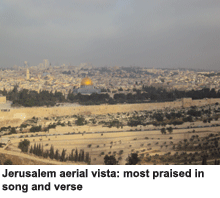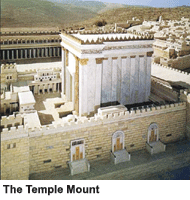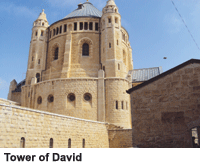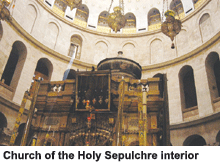Contemporary Jerusalem is not only the sacred city of the Jewish people worldwide but also the second holiest city of the global Christian community after the Vatican and the third holy city of Islam after Mecca and Medina
 Routinely included in the list of the world’s holiest cities together with the Vatican and Mecca, Jerusalem is arguably the most praised in song and verse among them. English literature is replete with references to “Jerusalem the Golden”, “new Jerusalem”, “shining city on the hill”, etc. In this biblical city, every street and monument makes the Book of Genesis and the prophets come alive. Contem-porary Jerusalem (pop.800,000) is mounted on terraces carved out of hills and the roads twist and turn sharply, at times so steeply that walking is not advised for all.
Routinely included in the list of the world’s holiest cities together with the Vatican and Mecca, Jerusalem is arguably the most praised in song and verse among them. English literature is replete with references to “Jerusalem the Golden”, “new Jerusalem”, “shining city on the hill”, etc. In this biblical city, every street and monument makes the Book of Genesis and the prophets come alive. Contem-porary Jerusalem (pop.800,000) is mounted on terraces carved out of hills and the roads twist and turn sharply, at times so steeply that walking is not advised for all.
We drove into Jerusalem from Amman, the capital of Jordan. At the bus depot, our passports were not stamped and our permits to enter the holy city were taken away as soon as we crossed the border.
Until 1967, half of Jerusalem was part and parcel of the Royal Kingdom of Jordan. But following the Arab-Israeli six-day war of that year in which Arab forces suffered a crushing defeat, control of the holy city was wrested by Israel. “An Israeli stamp on your passport will automatically bar you from visiting any other Muslim country,” explained our tour organiser. Since several Islamic countries were on our itinerary, we saw no cause to complain.
According to Jewish tradition, Jerusalem was first mentioned in the Book of Genesis (14:18), as synon-ymous with Salem. But according to our official tourist guide, the first recorded citation of Jerusalem was in ancient Egyptian texts. Yet the first authe-nticated reference to Jerusalem was by way of inscriptions on pottery bowls and figurines from the 19th century BCE (Before Christ Era). Five centuries later, the name Jerusalem was found in the archives of Ei-Amarna in Middle Egypt. In the Old Testament, the first reference to this holy city was made in the Book of Joshua, in a passage narrating an alliance between a king of Jerusalem and four other kings from the south against the Israelites.
Later according to the Old Testament, in 1000 BCE King David, who united the children of Israel after they wandered in the Sinai desert for over 500 years, captured Jerusalem and made it his capital and abode until his death in 970 BCE. David was succeeded by his son Solomon (965-925 BCE), who built the Holy Temple on Mount Moriah in 950 BCE. Solomon’s temple (later known as the First Temple) went on to play a pivotal role in Jewish history as the repository of the Ark of the Covenant. For more than 450 years, until the Babylonian conquest in 587 BCE, Jerusalem was the political capital of the united Kingdom of Israel and then the Kingdom of Judah.
Today, Jerusalem is the sacred city of Jewish people worldwide, and the epicentre of Judaism since 1000 BCE. Not surprisingly it is the second holiest city of the global Christian community after the Vatican. Moreover given the reference to ‘The Farthest Mosque’ in the holy Koran and subsequent construction of a mosque on the Temple Mount, Jerusalem is also venerated as the third holy city of Islam after Mecca and Medina.
Now declared a World Heritage site, the walled city has been traditionally divided into four quarters viz, Armenian, Christian, Jewish and Muslim. During its long history, Jerusalem has been destroyed twice, besieged 23 times, attacked 52 times and captured and recaptured 44 times. Indeed, political strife and conflict is endemic to Jerusalem and is one of the core issues of the Israeli-Palestinian conflict. Israel’s annexation of East Jerusalem in 1967 has been repeatedly criticised by the United Nations. The international community does not recognise Jerusalem as the capital of Israel, while Palestinians want East Jerusalem to be the capital of a future Palestinian state.
City of Gates. The Muslim Emperor Suleiman the Magnificent (1494-1566) built a wall that still surrounds the old city. The wall has eight gates each with a rich history of its own. These gates are: Jaffa, Dung, Zion, Golden, Lion’s, Herod’s, Damascus and New gates. Of these, Jaffa was one of the most important portals, along with Damascus gate. It marked the beginning of the routes to Hebron and the Arabs called it Hebron gate.
David’s Tomb. Believed to be the final resting place of King David, the tomb is situated in a corner of the remains of the former Hagia Zion, a Byzantine church. According to historical texts, the tomb was discovered in the 12th century during repairs to the church. Since 1949, a blue cloth, with basic modernist ornamentation, has been placed over the sarcophagus. The images on the cloth include several crown-shaped Rimmon placed over Torah scrolls, and a violin with the cloth also featuring several verses in Hebrew text. However, the authenticity of the site has been challenged time and again since according to the Hebrew Bible, David was actually buried within the City of David together with his forefathers.
 Dome of the Rock. This is the most revered Islamic site in Jerusalem. Built over a sacred rock, it’s believed to be the place from where Prophet Muhammad ascended into heaven. On the other hand, Jews venerate the rock as the site where in deference to Jehovah’s command, Abraham prepared to sacrifice his beloved son Isaac, an event which Muslims place in Mecca.
Dome of the Rock. This is the most revered Islamic site in Jerusalem. Built over a sacred rock, it’s believed to be the place from where Prophet Muhammad ascended into heaven. On the other hand, Jews venerate the rock as the site where in deference to Jehovah’s command, Abraham prepared to sacrifice his beloved son Isaac, an event which Muslims place in Mecca.
The extraordinary visual impact of the Dome of the Rock is in part due to the mathematical rhythm of its proportions. All the critical dimensions are related to the circle that surrounds the sacred stone. For example, each outer wall is 67 ft in length which is exactly the dome’s diameter and its exact height from the base.
 The Temple Mount. In 1000 BCE, after King David captured the city of Jerusalem from the Jebusites and made it the capital of the Israelites, he chose this high place as the site of a great temple to house the Ark of the Coven-ant. David’s son Solomon completed construction of the temple in 957 BCE. The First Temple was looted of its treasures, including the Ark of the Covenant and completely destroyed between 587-86 BCE by King Nebuchad-nezzar II of Babylon. Following the sack of Jerusalem in that year, the children of Israel were deported to Babylonia between 586 and 582 BCE (the Babylonian Exile). In 538 BCE, Emperor Cyrus II of Persia who had conquered Babylonia in 539 BCE allowed the Jews to return to Jerusalem and rebuild the temple.
The Temple Mount. In 1000 BCE, after King David captured the city of Jerusalem from the Jebusites and made it the capital of the Israelites, he chose this high place as the site of a great temple to house the Ark of the Coven-ant. David’s son Solomon completed construction of the temple in 957 BCE. The First Temple was looted of its treasures, including the Ark of the Covenant and completely destroyed between 587-86 BCE by King Nebuchad-nezzar II of Babylon. Following the sack of Jerusalem in that year, the children of Israel were deported to Babylonia between 586 and 582 BCE (the Babylonian Exile). In 538 BCE, Emperor Cyrus II of Persia who had conquered Babylonia in 539 BCE allowed the Jews to return to Jerusalem and rebuild the temple.
Construction of the Second Temple began in 538 BCE and was completed in 516 BCE. Almost five centuries later, circa 19 BCE, King Herod the Great of Judea expanded the perimeter of the temple to cover 36 acres and rebuilt the structure. Subsequently during the new Christ Era (CE) the temple was attacked and rebuilt several times and was ultimately transformed into an octagonal Islamic building by Caliph Abal Malik (691 CE). The shrine became known as the Dome of the Rock.
Following creation of the state of Israel in 1948 by a United Nations resolution, East Jerusalem and the Temple Mount was ceded to the Royal Kingdom of Jordan. But after the six-day war of 1967, Israel captured the Temple Mount and all of East Jerusalem. However the Israeli government left the Islamic waqf in control of the site. On June 7, 1967 Israel’s Knesset (Parliam-ent) declared it a “sacred place to all religions”. Nevertheless despite freedom of access being enshrined in the law, non-Muslim prayers are banned as a security measure.
The Last Supper Room. The Room of the Last Supper where Jesus shared his last meal with his 12 disciples before his crucifixion is sited just outside the Dormition Abbey — a massive fortress-like structure just beyond the Zion Gate. This simple room brings to mind the momentous events recounted in the Gospels, especially the institution of the Eucharist — which is routinely dispensed in Catholic and Anglican churches — following confession.
 Tower of David. Located near the Jaffa Gate, this citadel built in the 2nd century is now a museum presenting the history of Jerusalem. It delineates the milestones beginning in the second millennium BCE, until the city became the capital of the state of Israel, as well as its significance to the world’s premier revealed religions (Judaism, Christianity and Islam). This permanent exhibition illustrates the city’s history through the axis of time using myriad methods and includes explanations in Hebrew, Arabic and English. The museum also hosts lectures and special events in music, dance and drama, as well as dozens of educational activities and programmes and a unique sound and light show — The Night Spectacular.
Tower of David. Located near the Jaffa Gate, this citadel built in the 2nd century is now a museum presenting the history of Jerusalem. It delineates the milestones beginning in the second millennium BCE, until the city became the capital of the state of Israel, as well as its significance to the world’s premier revealed religions (Judaism, Christianity and Islam). This permanent exhibition illustrates the city’s history through the axis of time using myriad methods and includes explanations in Hebrew, Arabic and English. The museum also hosts lectures and special events in music, dance and drama, as well as dozens of educational activities and programmes and a unique sound and light show — The Night Spectacular.
 Church of the Holy Sepulchre. Also known as the Church of the Resurrection by Eastern Christians, it is sited in the old walled city and revered by Christians because it is believed to be the site of the Hill of Calvary where Jesus was crucified and is said to also contain the tomb where Jesus was buried (the sepulchre) for three days before his resurrection. Today, it also serves as the headquarters of the Greek Orthodox Patriarch of Jerusalem, even as control of the building is shared between several Christian churches and secular entities in complicated arrange-ments. The main attraction of the Church is the Stone of the Anointing on which according to legend, the body of Jesus was anointed by Joseph of Arimathea after it was taken down from the cross.
Church of the Holy Sepulchre. Also known as the Church of the Resurrection by Eastern Christians, it is sited in the old walled city and revered by Christians because it is believed to be the site of the Hill of Calvary where Jesus was crucified and is said to also contain the tomb where Jesus was buried (the sepulchre) for three days before his resurrection. Today, it also serves as the headquarters of the Greek Orthodox Patriarch of Jerusalem, even as control of the building is shared between several Christian churches and secular entities in complicated arrange-ments. The main attraction of the Church is the Stone of the Anointing on which according to legend, the body of Jesus was anointed by Joseph of Arimathea after it was taken down from the cross.
Arts and culture. While most tourists to Jerusalem are pilgrims visiting the city’s historic and sacred sites, modern Jerusalem is also a vibrant cultural and entertainment hub. Several world-class classical music concerts, including harp contests are staged in the Jerusalem Centre for the Performing Arts on Marcus Street. This venue and the Jerusalem Film Center on Hebron Road (the city’s trendy centre for art-house films) are worth visiting to absorb the buzz of creativity of Israel’s most talented performers. Moreover the Henry Crown Symphony Hall on Chopin Street hosts the excellent Jerusalem Symphony Orchestra and the world-renowned Israel Philharmonic Orchestra conducted by India-born Zubin Mehta, who rotates performances between Tel Aviv, Haifa and Jerusalem.
Dining. For gourmets, Jerusalem offers a wide choice of cuisine. Apart from the standard falafel joints, there are numerous European, Ethiopian, Mediterranean and Middle Eastern restaurants. Our favourite during a four-day stay here was Maoz Falafel, a tiny, historic eatery that has been a city-centre favourite since 1967. Another recommended restaurant is Darna on Horkanus Street, offering an extensive menu of North African and Middle-Eastern fare in a Moroccan-inspired setting.
Getting there. From any of India’s major airports, you can board a flight to the Ben Gurion Airport, a 40-minute drive from Jerusalem. You could opt for a bus, taxi or even rent a car.
Accommodation. Jerusalem has a long list of hotels and you can choose according to your budget. Among the deluxe hotels are the David Citadel Hotel, Inbal Hotel, Plaza Jerusalem and Regency Hotel, while those seeking tourist-class accommodation could check out the Ariel, Gold Jerusalem, Kikar Zion, Knesset Towers and Shalom hotels, among others.
Currency. The Israeli shekel is the currency of Jerusalem. One Indian rupee equals 11 Israeli shekel.
Huned Contractor